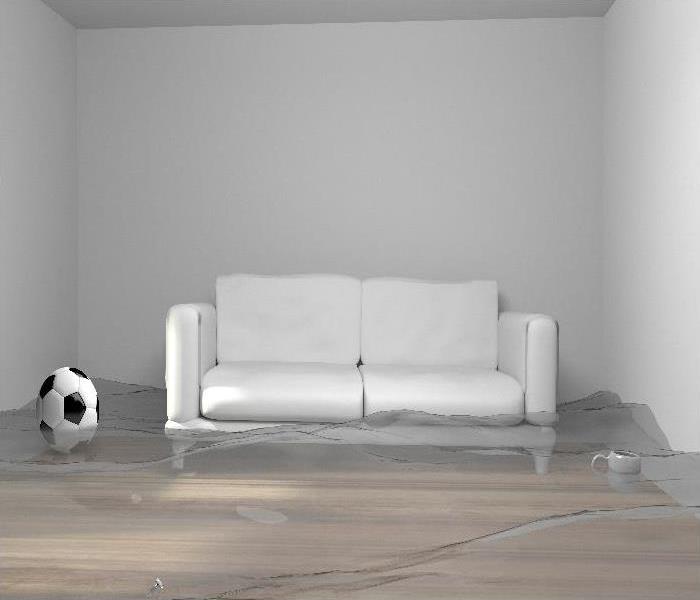How Do I Restore Different Flooring Materials After a Water Loss in Wilmington?
5/23/2020 (Permalink)
Your Wilmington Home Has Multiple Flooring Types, and Our SERVPRO Team Can Help You Clean Them After Water Loss Disasters
Most Wilmington homes do not have the same flooring throughout the entire structure, meaning that situations like water losses can impact all of these materials differently. The more than you know about how your home was constructed and what materials were used, the better you can appreciate the different tools, equipment, and techniques required to restore them after a loss.
From carpets to wood flooring, water cleanup in Wilmington homes is not a one-size-fits-all solution. Careful consideration must occur to ensure that the most efficient and effective practices are being utilized to save a customer time and money on the restoration work. Before any restoration work can officially begin on the individual materials affected by a water damage scenario, it can be beneficial to understand the process before our SERVPRO team arrives.
What Must Happen to Remove Water Damage from My Home?
While there are multiple phases and techniques that can be instrumental in both extraction and drying your home after a loss incident, each situation is different. In some situations, extraction is a wasted effort to the appropriately placed air movers and dehumidifiers throughout the house. Knowing what the house needs falls to the competent job scoping by our project manager and the information updated regularly in the DryBook software exclusive to our restoration brand. The steps of water restoration often involve these tasks:
• Extraction – This step involves removing surface water from flooring using submersible pumps and wet vacuums typically.
• Drying – This phase involves the broadest array of equipment, from air movers and dehumidifiers to drying mats and positive pressure systems.
• Controlled Demolition – Not every job requires controlled demolition, but it can provide access to damaged plumbing or help prevent further wicking of moisture into other drywall panels.
• Content Management – Protecting what matters most in your house involves relocating your belongings or cleaning them on-site. Ensuring your possessions’ safety and restoration can often be more valuable to homeowners than protecting their structure.
Can Wood Flooring Get Protected?
Wood flooring is a standard implement and material throughout area homes and businesses. It is not impossible to reduce the threat to this flooring with concentrated efforts beginning with extraction and drawing out moisture from the planks. To accomplish this, several advanced tools can help. Here are some areas of focus for our technicians working to reduce the loss of building materials:
• Surface Moisture – Standing water is one of the greatest threats to wood plank flooring because the cellulose in the planks continue to pull moisture from the surface into the material until they become oversaturated. Removing surface water with a combination of submersible pumps and wet vacuums can help to move to the drying stage promptly.
• Floor Mat Drying – While there are several drying tools like air movers and dehumidifiers that can help remove moisture and evaporate water damage, wood plank floors often respond best to direct evaporation strategies like floor mat drying systems.
• Cleaning the Surface – Once the water has gotten removed from the plank flooring and the flooring seems stable, it is crucial to take the time to clean and even resurface the material when necessary. Citrus and thymol oils are both excellent cleaning products to renew the shine to the floors.
Do Wet Carpets Require Removal?
Numerous factors play into whether wet carpets require removal, and often this involves the amount of time that these materials remain exposed and saturated by the water loss effects. Migrating beyond the fibers of the upper layer is common, so several tools and devices are necessary to remove trapped water and get the area dry enough to save the carpeting. These include:
• Carpet Wands – These attachments get used with powerful extractors and can focus suction on carpeted floors using similar implements to hot water extraction cleaning.
• Weighted Extractors – Using the weight of the technician involved through stationery and ride on tools, weighted extractors force the fibers, padding, and subflooring together to bring water to the surface for collection and disposal.
• Air Movers – Centrifugal air movers, especially low-profile units, are instrumental in floating carpets to dry the upper layer and the padding simultaneously.
Who Cleans Carpets After a Water Loss?
With a team of qualified cleaning technicians, we can restore the look and vibrancy of tired carpets after a loss. Not only can this remove set-in sediment and soiling, but it also can eliminate residual soiling from trapped water.
Restoring flooring after water losses can feel overwhelming, but our SERVPRO of Brandywine / Wilmington team can help. We have the tools to make losses “Like it never even happened.” Give us a call today at (302) 762-8080.






 24/7 Emergency Service
24/7 Emergency Service
